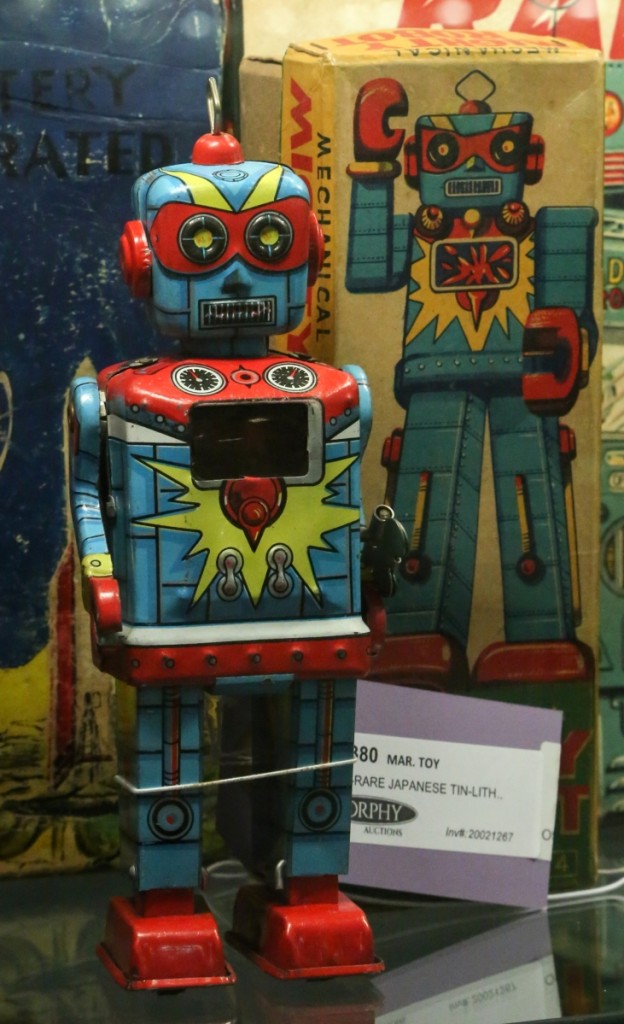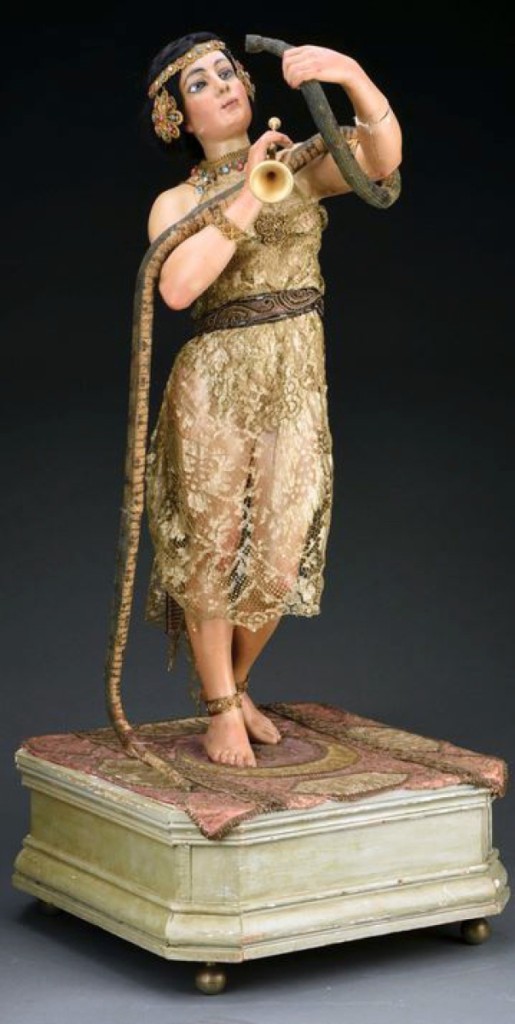
Sale specialist Tommy Sage Jr sits behind $126,075 worth of Mickey Mouse toys from the collection of Jeff Landes. The sale’s top lot sits at center, a German tin-litho windup Five Finger Mickey Mouse toy, which sold for $64,575. The result is an auction record for the model, besting the only other record that had ever been offered before. Sage believes it was made by Saalheimer & Strauss for the English market and it was in excellent condition. To the left, also by Saalheimer & Strauss, is a Mickey Mouse tin-litho mechanical bank that brought $35,670. On the right is a rare tin-litho Mickey Mouse and Felix the Cat sparkler toy, which is only one of a few prewar examples known. It was made in Spain by Rogelio Sanchiz for his company La Isla and was manufactured before 1936. The sparkler doubled estimate to sell for $25,830. Nearly all of Sanchiz’s toys were unlicensed by Disney and they remain some of the rarest in the field.
Review and Onsite Photos by Greg Smith, Additional Photos Courtesy Morphy Auctions
DENVER, PENN. – In the age of action heroes and the steady stream of explosive Hollywood reboots, leave it to Morphy Auctions to bring it back home to where it all began in 1928: Mickey Mouse. The lovable character we all grew up with claimed the top spot and other notable results at Morphy’s March 10-11 Toy, Doll and Figural Cast Iron sale. The auction included 1,260 lots of American tin toys, still and mechanical banks, cast iron cars, trains, character and Disney toys, German tin toys, as well as robots, antique European automata and a selection of horse-drawn cast iron, Japanese and pressed steel toys.
The sale grossed $1.6 million total and went 97 percent sold.
Two collections made the bulk of the auction, including those of Jeff Landes and Gordon B Lankton, who opened the Museum of Russian Icons in 2006.
Landes began collecting comic character toys in 1975 during his surgical residency in Philadelphia and continued on for the next 30 years. The collector was known to upgrade to finer examples when he found them, a practice that honed his collection into a quality assortment.
Three major tin litho Mickey Mouse toys finished in the top ten lots of the sale, all from Landes’ collection. Among them was the sale’s top lot, a 9-inch-high German windup Five Finger Mickey Mouse toy, which finished at $64,575. The toy was made in Germany for the English market, and was likely by Saalheimer & Strauss. When wound, Mickey dances back and forth and his cut-out pie eyes go up and down and his mouth opens up, revealing his tongue and teeth. Sale specialist Tommy Sage Jr said he had only ever seen one other example in his career, and it sold for $48,000 20 years ago, which would make this Morphy result the auction record for the model. Behind at $35,670 was a German Mickey Mouse mechanical bank in excellent condition. There were four versions of this toy made; this one features Mickey taking a picture on an old camera on the back, and when a coin is deposited, Mickey’s tongue comes out the front. Finally at $25,830 was a Mickey Mouse and Felix the Cat sparkler toy marked “La Isla R.S” for Rogelio Sanchiz, who manufactured the toy prior to 1936. When plunged in the back, Mickey Mouse bends over to light his cigar off of the spark, followed by Felix doing the same. Prewar toys from Spain are rare, and the condition of this one-in excellent to near mint-had the auction house saying it was likely one of the best examples known.
Selling above estimate at $28,800 was a Lionel Mickey Mouse Circus Train with original box in near mint condition. Of importance was its original unpunched cardboard sheet, which included 12 Mickey Mouse circus tickets, circus tent, flag, truck, Shell Gasoline station with pumps, and Mickey and Minnie running down the lane. The set came with tracks, a key-wound Lionel Lines engine with stoker tender and three circus cars. It sold to a collector in the room, who said, “It’s not a rare set, but the condition is rare. The condition drives the price.”

Specialist Tommy Sage Jr had never seen an example of Mighty Robot before. It was marked M, probably for Mitsuhashi. The first model to appear on the market, with its original box, went out at $41,205.
“I think that’s a world record,” Sage said, “$28,800 is a great price for that train. Usually boxed examples bring $8/12,000, this one brought twice that because of the unpunched cardboard.”
Other comic character toys from this collection did well. One of only a few examples known, a tin litho Felix the Cat Felix Frolic platform toy produced by J Chein would sell below estimate at $15,990. The only boxed example known of a tin and celluloid windup Elmer Elephant and Donald Duck Dancing Couple toy went out at double estimate for $13,530. A windup Popeye Air-O-Plane with original box sold at $9,225. Sage called it one of the rarest and most desirable Linemar toys and one of the rarest and most desirable Popeye toys. Two bidders agreed, and it sold to the phone.
An offering of French Automata from an American collection consisted of seven examples, which produced some high flying results. Selling between estimate at $55,350 was the 36-inch-high “Charmeuse De Serpent” (The Snake Charmer), made by Jean Roullet.
The form is exceptional and the piece worked well, according to Sage.
“The collection was really fine, they were all in good condition for being 125 years old. You don’t find these every day. This is probably the best grouping we’ve had in 16 years,” Sage said.
Three automatons by Gustav Vichy included the man in the moon figure “Lune Fin De Siecle,” (End of the Century Moon), which took $33,823. It was featured in Automata The Golden Age by Christian Bailly and is one of the maker’s best known models. Vichy was the first manufacturer who brought all of the elements of automaton-making into one workshop. “Negre De La Louisane” (Black Louisiana Man), would sell for $25,600 and “Equilibriste,” circa the 1880s, sold for $18,450.
In Japanese tin litho robots, a Mighty Robot with original box rose to the top at $41,205. It was marked M, likely for Mitsuhashi. Sage said he had never seen one before and didn’t know the company had made it. This was the first model to appear on the market. Not far behind at $27,675 was a Jupiter Robot, made by Yonezawa. The toy came with its original box and never-before-seen instruction sheet and Sage said he has only ever sold one other example. From there it was a long way to the Missile Man robot, which tripled estimate to bring $2,768. That robot was made by Alps and distributed by Rosco.

The top automaton in the sale was this “Charmeuse De Serpent” (The Snake Charmer), made by Jean Roullet, that sold for $55,350. It measures 36 inches high and was in exceptional working condition.
In cast iron mechanical banks, a J&E Stevens Horse Race bank with a straight base variation in near mint condition with the original box went out at $24,000. There are only three boxes known for that bank. A Kyser and Rex Roller Skating Rink in excellent condition followed behind at $21,000. A Chronometer bank in near mint condition sold between estimate at $11,685. Morphy said there are probably a couple dozen known, but the condition of this example made it among the best examples. Morphy had pulled it out of a house a decade ago and sold it then, and was reoffering it from that collection here. At $11,070 was a Red Riding Hood bank by W.S. Reed in excellent condition.
Among the cast iron offerings, some of the most coveted pieces were three blinking eye case clocks that drew stiff competition among bidders. Three dealers in the room tried their hands individually on the lots and were all swept by the phones. Rising above its $8,000 estimate to sell for $19,680 was a Samurai Warrior on Base in excellent condition. It is one of two known. Sage said the example was in all original condition with the original functional works inside. The firm had never sold another. At $11,070 was a Bradley and Hubbard Santa in very good condition, though with some paint restoration on it. Another Bradley and Hubbard, the Gambrinus King of Beers, brought $5,100. The King is one of the rarest clocks from B&H, but this one was in repainted condition.
Following the sale, Sage said he was relieved to have gotten through it. The Tuesday/Wednesday auction was held during a chaotic time in the US stock market and it snuck in the day before major cancellations began to occur due to the coronavirus. But he related he has dealt through some tumultuous times in the past, and it is not all bad.
“Eighty percent of the lots sold to the internet,” Sage said. “It helps in a way that people are home, they’re house-bound and they can sit on the internet and bid. It works both ways. And I know people who have pulled money out of the stock market and they’re spending it in our sales, so some things hurt you and they help you. Some people pull their profit out and they want to buy tangible things.”
The firm’s next Toys, Dolls & Figural Cast Iron sale is scheduled for September 23-24. Morphy’s next scheduled sale is the Coin-Op & Advertising auction on March 28-29. For information, www.morphyauctions.com.































